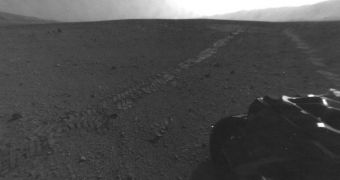Mission controllers at the NASA Jet Propulsion Laboratory (JPL) in Pasadena, California, say that the Mars Science Laboratory (MSL) rover Curiosity has begun its long trek towards its first science target, an outcrop called Glenelg.
Located about 400 meters (1,312 feet) away from Bradbury landing, where the robot touched down on the Martian surface, the geological feature promises to provide the rover with an interesting series of first science results for its advanced suite of instruments.
On Tuesday, August 28, JPL drivers relayed the move commands towards Mars. Curiosity promptly complied, and drove a total of 16 meters (52 feet) on sol 22. A sol (Martian day) lasts for 24 hours and 39 minutes, experts say.
While the first two drives the rover carried out were meant to assess the performances of its mobility system, and to investigate the scorch marks left on the Martian surface by the Sky Crane's rocket engines, the latest one is designed to take the rover closer to its first real target.
Once at Glenelg, Curiosity may use the drill on its robotic arm for the first time. However, JPL scientists say that this could happen ever before the outcrop is reached, if the robot comes across an interesting geological formation.
“This drive really begins our journey toward the first major driving destination, Glenelg, and it's nice to see some Martian soil on our wheels. The drive went beautifully, just as our rover planners designed it,” says JPL MSL mission manager, Arthur Amador.
“We are on our way, though Glenelg is still many weeks away. We plan to stop for just a day at the location we just reached, but in the next week or so we will make a longer stop,” adds Curiosity project scientist John Grotzinger, who is based at the California Institute of Technology (Caltech).
The robot is currently using its MastCam instrument to collect images of the slopes of Mount Sharp, its ultimate destination. By capturing photos from several locations, experts can observe landscape features in 3D, which makes it easier for them to calculate a safer route for Curiosity to take.
MSL scientists are convinced that Glenelg – an intersection of three types of material – will provide them with the first batch of usable data in this two-year mission. Curiosity's ultimate goal is to determine if Gale Crater, its new home, was ever capable of supporting life.
The mission is managed by JPL for NASA. Caltech in turn manages the JPL for the NASA Science Mission Directorate, at the American space agency's Headquarters, in Washington DC.

 14 DAY TRIAL //
14 DAY TRIAL //